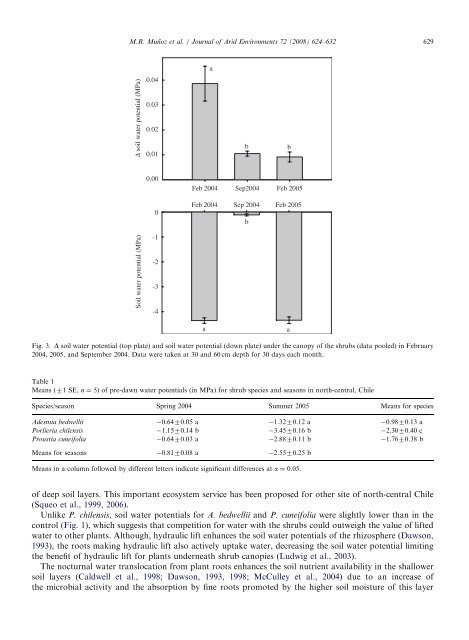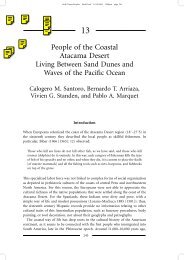ARTICLE IN PRESS M.R. Muñoz et al. / Journal of Arid Environments 72 (2008) 624–632 629 a Δ soil water potential (MPa) 0.04 0.03 0.02 0.01 b b 0.00 0 Feb 2004 Sep2004 Feb 2005 Feb 2004 Sep 2004 Feb 2005 b Soil water potential (MPa) -1 -2 -3 -4 a a Fig. 3. D soil water potential (top plate) and soil water potential (down plate) under <strong>the</strong> canopy of <strong>the</strong> <strong>shrub</strong>s (data pooled) <strong>in</strong> February 2004, 2005, and September 2004. Data were taken at 30 and 60 cm depth for 30 days each month. Table 1 Means (71 SE, n ¼ 5) of pre-dawn water potentials (<strong>in</strong> MPa) for <strong>shrub</strong> <strong>species</strong> and seasons <strong>in</strong> north-central, Chile Species/season Spr<strong>in</strong>g 2004 Summer 2005 Means for <strong>species</strong> Adesmia bedwellii 0.6470.05 a 1.3270.12 a 0.9870.13 a Porlieria chilensis 1.1570.14 b 3.4570.16 b 2.3070.40 c Proustia cuneifolia 0.6470.03 a 2.8870.11 b 1.7670.38 b Means for seasons 0.8170.08 a 2.5570.25 b Means <strong>in</strong> a column followed by different letters <strong>in</strong>dicate significant differences at a ¼ 0.05. of deep soil layers. This important ecosystem service has been proposed for o<strong>the</strong>r site of north-central Chile (Squeo et al., 1999, 2006). Unlike P. chilensis, soil water potentials for A. bedwellii and P. cuneifolia were slightly lower than <strong>in</strong> <strong>the</strong> control (Fig. 1), which suggests that competition for water with <strong>the</strong> <strong>shrub</strong>s could outweigh <strong>the</strong> value of <strong>lift</strong>ed water to o<strong>the</strong>r plants. Although, hydraulic <strong>lift</strong> enhances <strong>the</strong> soil water potentials of <strong>the</strong> rhizosphere (Dawson, 1993), <strong>the</strong> roots mak<strong>in</strong>g hydraulic <strong>lift</strong> also actively uptake water, decreas<strong>in</strong>g <strong>the</strong> soil water potential limit<strong>in</strong>g <strong>the</strong> benefit of hydraulic <strong>lift</strong> for plants underneath <strong>shrub</strong> canopies (Ludwig et al., 2003). The nocturnal water translocation <strong>from</strong> plant roots enhances <strong>the</strong> soil nutrient availability <strong>in</strong> <strong>the</strong> shallower soil layers (Caldwell et al., 1998; Dawson, 1993, 1998; McCulley et al., 2004) due to an <strong>in</strong>crease of <strong>the</strong> microbial activity and <strong>the</strong> absorption by f<strong>in</strong>e roots promoted by <strong>the</strong> higher soil moisture of this layer
630 ARTICLE IN PRESS M.R. Muñoz et al. / Journal of Arid Environments 72 (2008) 624–632 (Junk, 1996), i.e. <strong>the</strong> changes <strong>in</strong>duced by roots <strong>in</strong> <strong>the</strong> nitrogen (Griffiths and Robison, 1992) and micronutrient m<strong>in</strong>eralization (Marschner and Ro¨mhekd, 1996). Beneath <strong>shrub</strong> canopies <strong>the</strong>re are higher nutrient concentrations and microorganisms than <strong>in</strong> <strong>the</strong> open areas (Herman et al. 1995; Pugnaire et al., 1996; Schles<strong>in</strong>ger et al., 1990; Titus et al., 2002). In <strong>the</strong> <strong>Chilean</strong> <strong>coastal</strong> desert, soils under <strong>the</strong> canopies of P. chilensis and A. bedwellii conta<strong>in</strong> more nutrients than <strong>the</strong> surround<strong>in</strong>g open areas (Aguilera et al., 1999; Gutie´rrez et al., 1993b). <strong>Hydraulic</strong> <strong>lift</strong> could be importantly contribut<strong>in</strong>g to <strong>the</strong> formation of <strong>the</strong>se ‘‘fertility islands’’. Acknowledgments We are grateful to Corporacio´n Nacional Forestal (CONAF), IV Region, and <strong>in</strong> particular to W. Canto and J.M. Torres for permitt<strong>in</strong>g <strong>the</strong> realization of this project <strong>in</strong> Parque Nacional Bosque Fray Jorge. We appreciate <strong>the</strong> valuable comments and suggestions of Milena Holmgren and Darren Sandquist on an early version of <strong>the</strong> manuscript. Support for this project has come <strong>from</strong> <strong>the</strong> Chile’s Fondo Nacional de Ciencia y Tecnologı´a (FONDECYT 1030225). References Aguilera, L.E., Gutiérrez, J.R., Meserve, P.L., 1999. Variation <strong>in</strong> soil micro-organisms and nutrients underneath and outside <strong>the</strong> canopy of Adesmia bedwellii (Papilionaceae) <strong>shrub</strong>s <strong>in</strong> arid <strong>coastal</strong> Chile follow<strong>in</strong>g drought and above average ra<strong>in</strong>fall. Journal of Arid Environments 42, 61–70. Aust<strong>in</strong>, A.T., Yahdjian, L., Stark, J.M., Belnap, J., Porporato, A., Norton, U., Ravetta, D.A., Schaeffer, S.M., 2004. Water pulses and biogeochemical cycles <strong>in</strong> arid and semiarid ecosystems. Oecologia 141, 221–235. Caldwell, M.M., Dawson, T.E., Richards, J.H., 1998. <strong>Hydraulic</strong> <strong>lift</strong>: consequences of water efflux <strong>from</strong> <strong>the</strong> roots of plants. Oecologia 131, 151–161. Corak, S.J., Blev<strong>in</strong>s, D.G., Pollardy, S.G., 1987. Water transfer <strong>in</strong> an alfalfa/maize association: survival of maize dur<strong>in</strong>g drought. Plant Physiology 84, 582–586. Dawson, T.E., 1993. <strong>Hydraulic</strong> <strong>lift</strong> and water use by plants—implications for water balance, performance and plant-plant <strong>in</strong>teractions. Oecologia 95, 565–574. Dawson, T.E., 1998. Water loss <strong>from</strong> tree roots <strong>in</strong>fluences soil water and nutrient status and plant performance. In: Flores, H.E., Lynch, J.P., Eissenstat, D.M. (Eds.), Radical Biology: Advances and Perspectives <strong>in</strong> <strong>the</strong> Function of Plant Roots. Current Topics <strong>in</strong> Plant Physiology, vol. 17. American Society of Plant Physiologists, Rockville, MD, USA (special issue, Plant Physiology). Dawson, T.E., Pate, J.S., 1996. Seasonal water uptake and movement <strong>in</strong> root systems of Australian phreatophytic plants of dimorphic root morphology: a stable isotope <strong>in</strong>vestigation. Oecologia 107, 13–20. Ehler<strong>in</strong>ger, J.R., Schw<strong>in</strong>n<strong>in</strong>g, S., Gebauer, R.L., 1999. Water use <strong>in</strong> arid land ecosystems. In: Press, M.C. (Ed.), Advances <strong>in</strong> Plant Physiological Ecology. Blackwell Science, Oxford, pp. 347–365. Filella, I., Pen˜uelas, J., 2003. Indications of hydraulic <strong>lift</strong> by P<strong>in</strong>us halepensis and its effects on <strong>the</strong> water relations of neighbour <strong>shrub</strong>s. Biologia Plantarum 47, 209–214. Griffiths, B., Rob<strong>in</strong>son, D., 1992. Root-<strong>in</strong>duced nitrogen m<strong>in</strong>eralisation: a nitrogen balance model. Plant and Soil 139, 253–263. Gutiérrez, J.R., Squeo, F.A., 2004. Importancia de los arbustos len˜osos en los ecosistemas semiáridos de Chile. Ecosistemas 13 (1), URL: /http://www.aeet.org/ecosistemas/041/<strong>in</strong>vestigacion2.htmS. Gutiérrez, J.R., Meserve, P.L., Jaksic, F.M., Contreras, L.C., Herrera, S., Va´squez, H., 1993a. Structure and dynamics of vegetation <strong>in</strong> a <strong>Chilean</strong> thorn scrub community. Acta Oecologica 14, 271–285. Gutiérrez, J.R., Meserve, P.L., Contreras, L.C., Va´squez, H., Jaksic, F.M., 1993b. Spatial distribution and soil nutrients and ephemeral plants underneath and outside <strong>the</strong> canopy of Porlieria chilensis (Zygophyllaceae) <strong>shrub</strong>s <strong>in</strong> arid <strong>coastal</strong> Chile. Oecologia 95, 347–352. Gutiérrez, J.R., Meserve, P.L., Kelt, D.A., 2004. In: Squeo, F.A., Gutiérrez, J.R., Hernández, I.R. (Eds.), Estructura y d<strong>in</strong>ámica de la vegetación del ecosistema semiárido del Parque Nacional Bosque Fray Jorge entre 1989 y 2002. vol. 6. Ediciones Universidad de La Serena, La Serena, Chile, pp. 115–134. Gutiérrez, J.R., Holmgren, M., Manrique, R., Squeo, F.A., 2007. Reduced herbivore pressure under ra<strong>in</strong>y ENSO conditions could facilitate dryland reforestation. Journal of Arid Environments 68, 322–330. Herman, R.P., Provencio, K.R., Herrera-Matos, J., Torrez, R.J., 1995. Resource islands predict <strong>the</strong> distribution of heterotrophic bacteria <strong>in</strong> Chichuahuan desert soils. Applied and Environmental Microbiology 61, 1816–1821. Hirota, I., Sakuratani, T., Sato, T., Higuchi, H., Nawata, E., 2004. A split-root apparatus for exam<strong>in</strong><strong>in</strong>g <strong>the</strong> effects of hydraulic <strong>lift</strong> by trees on <strong>the</strong> water status of neighbour<strong>in</strong>g crops. Agroforestry Systems 60, 181–187. Holmgren, M., Stapp, P., Dickman, C.R., Gracia, C., Graham, S., Gutiérrez, J.R., Hice, C., Jaksic, F., Kelt, D.A., Letnic, M., Lima, M., Lo´pez, B.C., Meserve, P.L., Milstead, W.B., Polis, G.A., Previtali, M.A., Richter, M., Sabaté, S., Squeo, F.A., 2006. Extreme climatic events shape arid and semiarid ecosystems. Frontiers <strong>in</strong> Ecology and <strong>the</strong> Environment 4, 87–95. Horton, J.L., Hart, S., 1998. <strong>Hydraulic</strong> <strong>lift</strong>: a potentially important ecosystem process. Trends <strong>in</strong> Ecology and Evolution 13, 232–235.

















